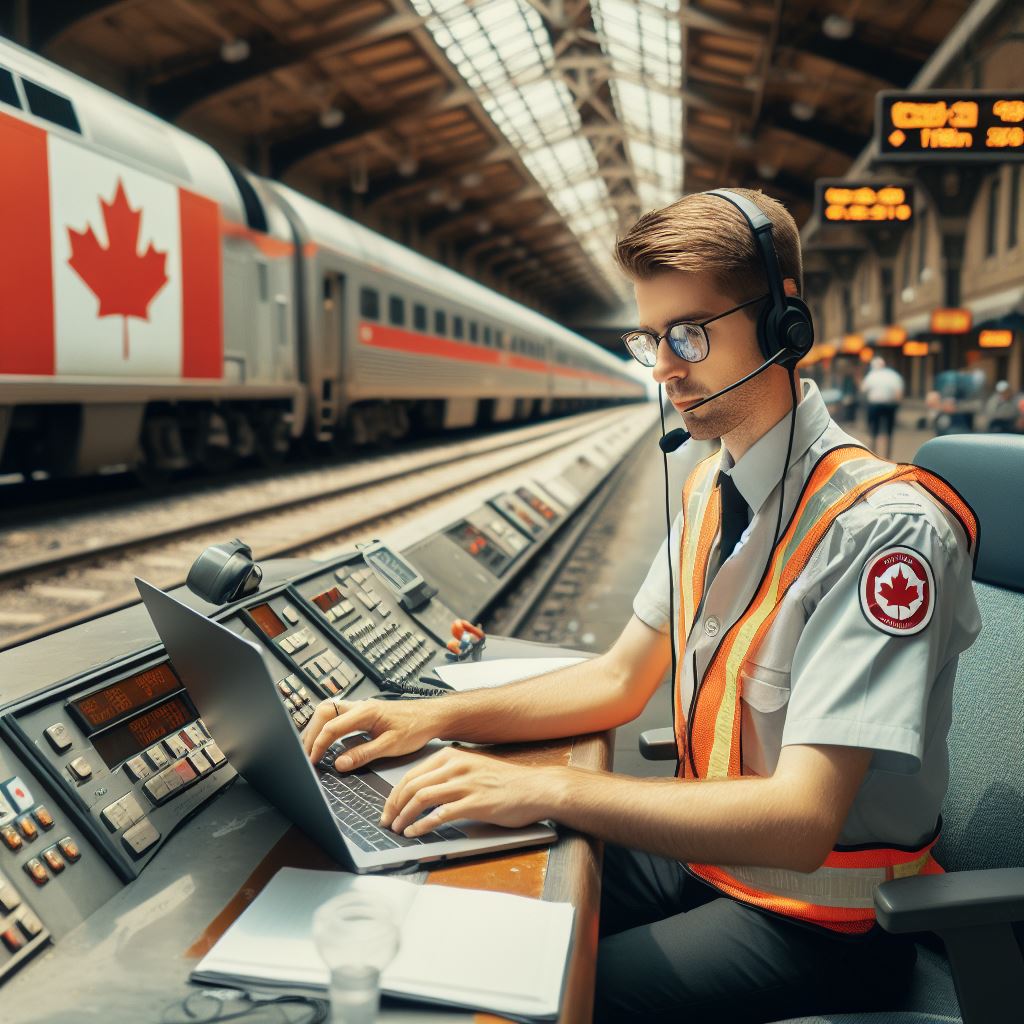Introduction
Railway operator safety practices are of utmost importance in Canada.
The country has the third-largest rail network in the world, with nearly 41,711 route-kilometers of track.
The Canadian rail system has both federal and provincial railways.
Railways that cross provincial or international boundaries are governed federally.
Railways that only operate within a province are governed provincially.
Transport Canada’s Rail Safety Program develops and implements policies and regulations, and administers the Railway Safety Act.
The department conducts approximately 40,000 railway safety inspections every year.
The Railway Safety Management System Regulations, 2015, provide a framework for companies to integrate safety into their day-to-day railway operations.
This blog post will focus on the updated work/rest rules for railway operating employees introduced by Transport Canada in 2011.
The requirement for fatigue management plans was introduced to the Work/Rest Rules for Railway Operating Employees in 2011.
Since then, several updates have been made to better target the issue of railway operator fatigue.
The table below provides a summary of these updates. The new rules will come into effect on January 1, 2025.
The Role of Regulatory Bodies in Ensuring Safety
Introduction to regulatory bodies responsible for overseeing railway safety in Canada
- The Transport Canada’s Rail Safety Directorate is the main regulatory body in Canada.
- Other key regulatory bodies include the Canadian Transportation Agency (CTA) and the Railway Association of Canada (RAC).
- These bodies work collaboratively to ensure the safety and efficiency of the railway system.
Responsibilities and functions of these regulatory bodies
- Transport Canada’s Rail Safety Directorate is responsible for creating and implementing safety regulations.
- They enforce compliance with safety standards and ensure the overall safety of railway operations.
- The Canadian Transportation Agency (CTA) provides regulatory oversight and addresses customer complaints.
- The Railway Association of Canada (RAC) represents the interests of railway operators and promotes safety.
Examples of specific safety regulations and standards in place
- Rules and regulations for train operating crews, such as maximum working hours and mandatory rest periods.
- Regulations on track maintenance and inspections to prevent accidents caused by infrastructure failures.
- Strict safety protocols for handling dangerous goods and hazardous materials during transportation.
- Requirements for operator training and certification to ensure competence in operating railway equipment.
In short, regulatory bodies play a crucial role in ensuring safety within the Canadian railway industry.
The Transport Canada’s Rail Safety Directorate, Canadian Transportation Agency (CTA), and Railway Association of Canada (RAC) work together to establish and enforce safety regulations.
These regulations cover various aspects such as crew working hours, track maintenance, hazardous materials handling, and operator training.
By overseeing compliance with these standards, these bodies contribute to maintaining a safe and efficient railway system in Canada.
Read: Career Path: Becoming a Train Conductor
Training and Certification Requirements
Overview of the training and certification process for railway operators in Canada
- Railway operators in Canada are required to undergo a comprehensive training and certification process.
- This process ensures that operators have the necessary skills, knowledge, and qualifications to perform their duties safely and effectively.
- Training programs are designed to cover various aspects of railway operations, including safety protocols, equipment operation, and emergency procedures.
- Once the training is completed, operators must pass a certification exam to demonstrate their proficiency in the field.
Specific skills, knowledge, and qualifications needed to become a certified operator
- Being a railway operator requires a combination of technical skills, knowledge of railway systems, and strong problem-solving abilities.
- Operators must have a deep understanding of safety regulations, signaling systems, and communication protocols.
- They need to possess excellent hand-eye coordination and the ability to react quickly in high-pressure situations.
- Moreover, operators should have strong situational awareness, attention to detail, and the ability to work well in a team.
Ongoing training requirements and professional development opportunities
- Continuous learning and professional development are essential for railway operators to stay updated with industry advancements.
- Operators are required to undergo regular refresher training to ensure that their knowledge and skills are up to date.
- Professional development opportunities, such as workshops and seminars, are also available for operators to enhance their skills further.
- These opportunities allow operators to learn about new technologies, safety practices, and improvements in the railway industry.
Generally, the training and certification requirements for railway operators in Canada are rigorous and comprehensive.
Operators go through a structured training process to acquire the necessary skills and knowledge, ensuring the safe and efficient operation of railway systems.
Ongoing training and professional development opportunities are also available to keep operators updated with the latest industry practices and advancements.
This commitment to continuous improvement plays a vital role in maintaining high safety standards in the Canadian railway industry.
Read: Canadian Rail Operator: Skills and Qualifications
Safety Equipment and Technology
Overview of the safety equipment used by railway operators in Canada
Railway operators in Canada rely on a range of safety equipment to ensure the protection of their workers and passengers.
These equipment are essential in preventing accidents, mitigating risks, and ensuring the smooth operation of railways.
Personal Protective Equipment (PPE)
One crucial safety equipment used by railway operators is Personal Protective Equipment (PPE). PPE includes items such as high-visibility clothing, hard hats, safety glasses, and steel-toed boots.
Unlock Your Career Potential
Visualize a clear path to success with our tailored Career Consulting service. Personalized insights in just 1-3 days.
Get StartedThese protective gear are designed to safeguard workers from physical hazards and increase their visibility in the rail yard or construction sites.
Automatic Warning System (AWS)
Another vital safety tool employed by railway operators is the Automatic Warning System (AWS).
AWS is an integrated system of audio and visual signals that warns train operators about potential hazards on the tracks.
It alerts them about upcoming speed restrictions, signals, and other factors that may affect their operation.
The AWS plays a fundamental role in preventing collisions and keeping railway operators and passengers safe.
Advanced Train Control Systems (ATCS)
Additionally, Advanced Train Control Systems (ATCS) have significantly improved railway operator safety.
These sophisticated systems utilize GPS, sensors, and communication technologies to monitor train movements, prevent collisions, and manage train speeds.
ATCS combines automation and human intervention, enhancing operator control and reducing the risks associated with human errors or misjudgments.
Importance and effectiveness of safety tools such as automatic braking systems and warning signals
Automatic braking systems are vital safety tools that have revolutionized railway operations in Canada.
These systems use a combination of sensors and algorithms to automatically apply brakes when a potential collision or hazard is detected.
They act as a failsafe mechanism, addressing human errors, unexpected obstacles, or equipment malfunctions.
The introduction of warning signals, both auditory and visual, have significantly enhanced safety standards for railway operators.
Auditory signals, such as sirens or bells, alert both operators and pedestrians about an approaching train.
Visual signals, such as flashing lights or crossing barriers, serve as a visual reminder for individuals to remain clear of the tracks.
These warning signals contribute to accident prevention and ensure the safety of both railway operators and the general public.
Emerging technologies and their impact on improving operator safety
Positive Train Control (PTC)
One such technology is Positive Train Control (PTC).
PTC combines advanced communication systems, GPS, and track sensors to monitor train movements, control train speed, and prevent accidents.
PTC is highly effective in reducing the risks associated with human error, signal violations, and train derailments.
Use of drones for surveillance and inspection purposes
Another emerging technology that shows great promise in enhancing operator safety is the use of drones for surveillance and inspection purposes.
Drones equipped with cameras and sensors can provide real-time footage of railway tracks, allowing operators to identify potential hazards or maintenance issues before they escalate.
By using drones, railway operators can enhance their situational awareness and make informed decisions in real-time.
In general, safety equipment and technology play a vital role in ensuring the safety of railway operators in Canada.
Personal Protective Equipment, Automatic Warning Systems, Advanced Train Control Systems, automatic braking systems, warning signals, Positive Train Control, and drones are just some of the tools and technologies contributing to improved safety standards.
As technology advances, the railway industry can look forward to even more innovative solutions that will further enhance operator safety and ensure the continued safe operation of Canada’s railways.
Read: A Day in the Life of a Train Operator in Canada
Standard Operating Procedures and Safety Protocols
Introduction to the standard operating procedures followed by railway operators in Canada
- Railway operators in Canada adhere to strict standard operating procedures for ensuring safety.
- These procedures are designed to minimize risks and maintain efficient railway operations.
- Standard operating procedures are based on industry regulations and guidelines set by regulatory bodies.
- These procedures cover various aspects of railway operations, including maintenance, signaling, and train handling.
- Compliance with standard operating procedures is essential to avoid accidents and ensure public safety.
Safety protocols and guidelines for various operational situations
- Railway operators in Canada have specific safety protocols for different operational scenarios.
- These protocols outline the actions and precautions to be taken by operators in case of emergencies.
- For example, procedures for handling derailments, fires, hazardous material spills, and extreme weather conditions are defined.
- Operators are trained to follow these protocols to minimize harm and prevent further damage.
- Regular drills and simulations are conducted to familiarize operators with the safety protocols and ensure preparedness.
Examples of best practices and case studies highlighting effective safety protocols
- Several examples demonstrate the effectiveness of safety protocols followed by railway operators in Canada.
- In a recent case study, prompt adherence to safety protocols prevented a major train collision.
- Best practices include clear communication, thorough inspections, and immediate reporting of any safety concerns.
- Operators are encouraged to use safety checklists, maintain situational awareness, and prioritize public safety.
- Continuous improvement of safety protocols based on lessons learned from past incidents is also emphasized.
Essentially, standard operating procedures and safety protocols play a crucial role in ensuring the safety of railway operations in Canada.
Railway operators strictly adhere to these procedures and guidelines to minimize risks and prevent accidents.
The protocols cover various operational scenarios and are regularly updated based on best practices and feedback from past incidents.
By prioritizing public safety and continuous improvement, railway operators in Canada maintain a high level of safety in their day-to-day operations.
Read: Public Transit in Canada: Roles and Duties

Workplace Safety Culture
Importance of Fostering a Strong Safety Culture within the Railway Industry
Within the railway industry, fostering a strong safety culture is of paramount importance.
It ensures that safety is prioritized and ingrained in every aspect of operations.
A robust safety culture promotes employee well-being, prevents accidents, and protects the public.
Initiatives and Programs to Promote Safety Awareness and Accountability
To promote safety awareness and accountability, railway companies in Canada have implemented several initiatives and programs.
These aim to educate employees, emphasize the importance of safety, and ensure compliance with regulations and standards.
One such program is comprehensive safety training provided to all railway personnel.
This includes training on hazardous materials handling, emergency response, and personal protective equipment usage.
Training is ongoing and tailored to specific roles and responsibilities.
Additionally, safety initiatives like safety audits, inspections, and safety reporting systems have been introduced.
These mechanisms encourage employees to report unsafe conditions, near misses, and incidents.
They also foster a culture of continuous improvement by identifying areas for enhancement and implementing corrective actions promptly.
Feedback channels, such as safety suggestion programs and employee safety committees, further emphasize the importance of employee participation in maintaining a strong safety culture.
It encourages employees to voice their safety concerns, propose safety measures, and actively contribute to safety-related decision-making processes.
Successful Safety Culture Implementation in Canadian Railway Companies
Several Canadian railway companies have successfully implemented robust safety cultures, resulting in improved safety performance and reduced accidents.
One notable example is the Canadian Pacific Railway (CPR).
CPR has a strong safety culture deeply embedded in its operations.
It has implemented initiatives such as Safety Starts Here, a program emphasizing employee engagement, communication, and proactive hazard identification.
CPR’s safety metrics have improved significantly over the years, showcasing the effectiveness of their safety culture.
Another success story is the Canadian National Railway (CNR). CNR focuses on fostering a safety culture that revolves around continuous learning and improvement.
Their initiatives include targeted safety campaigns, safety recognition programs, and a comprehensive safety reporting system.
These efforts have led to a significant reduction in workplace injuries and accidents.
The success of these companies’ safety cultures can be attributed to their top-down commitment to safety, consistent communication, and employee involvement.
They prioritize safety at all levels of the organization, promote open dialogue, and provide resources to address safety concerns promptly.
In essence, fostering a strong safety culture within the railway industry is crucial for ensuring workplace safety and preventing accidents.
Initiatives and programs aimed at promoting safety awareness and accountability play a vital role in achieving this.
Canadian railway companies, such as CPR and CNR, serve as examples of successful safety culture implementation, demonstrating the positive impact it has on overall safety performance.
Challenges and Future Outlook
Identification of the challenges faced in maintaining and improving railway operator safety practices
- Ensuring compliance with safety regulations is a constant challenge for railway operators.
- Developing and implementing effective safety training programs for employees.
- Managing fatigue risks among railway operators due to long working hours and irregular schedules.
- Addressing the increasing mental health concerns among railway operators.
- Dealing with the risks associated with moving hazardous materials by rail.
- Effective communication and coordination among different railway operators and stakeholders.
- Adapting to technological advancements while ensuring its safe implementation.
- Balancing the need for safety with operational efficiency and cost-effectiveness.
- Encouraging a safety culture and promoting accountability at all levels within railway organizations.
- Managing the risks posed by extreme weather events and natural disasters.
Ongoing efforts and strategies to address these challenges
- Enhancing safety regulations and enforcement through collaboration between regulatory bodies and railway operators.
- Investing in advanced training techniques and technologies to improve employee safety and performance.
- Implementing fatigue management programs and schedules that prioritize adequate rest for railway operators.
- Introducing mental health support systems and resources for railway operators.
- Strengthening emergency response protocols and preparedness for incidents involving hazardous materials.
- Establishing effective communication channels and sharing best practices among railway operators.
- Conducting thorough risk assessments and safety audits before implementing new technologies.
- Investing in research and development of innovative safety solutions.
- Encouraging reporting of safety concerns and implementing a fair and transparent accountability system.
- Collaborating with meteorological and disaster management agencies to mitigate risks associated with extreme weather events.
Potential future advancements and trends in railway operator safety
- Integration of artificial intelligence and machine learning in predicting and preventing accidents.
- Development of advanced sensor technologies to detect hazards and potential safety risks.
- Implementation of autonomous train operation systems to eliminate human error.
- Adoption of virtual reality training programs to enhance situational awareness and decision-making skills.
- Incorporation of predictive maintenance techniques to minimize equipment failures and enhance safety.
- Utilization of big data analytics for identifying safety trends and improving safety measures.
- Introduction of biometric monitoring systems to enhance operator health and wellness.
- Integration of blockchain technology for secure and transparent record-keeping of safety-related data.
- Collaboration with academic institutions and research organizations to drive innovation in railway safety.
- Continuous evaluation and improvement of safety practices based on lessons learned from incidents and accidents.
In a nutshell, maintaining and improving railway operator safety practices in Canada comes with multiple challenges.
However, through ongoing efforts and strategies, such as enhancing regulations, investing in training and technology, and fostering a safety culture, the future outlook for railway operator safety is promising.
The exploration of potential advancements, including AI integration, advanced sensors, and virtual reality training, demonstrates the industry’s commitment to staying at the forefront of safety practices.
Conclusion
This blog has highlighted the crucial aspects of railway operator safety practices in Canada.
Through the blog post, the following key points have been covered:
- Importance of maintaining safe railway operations in Canada.
- Overview of safety regulations and protocols in the industry.
- Role of technology in enhancing safety measures.
- Training and education programs for railway operators.
- Collaboration between industry stakeholders and regulatory bodies.
It is essential to reinforce the significance of railway operator safety practices in Canada.
Safety should always be a top priority for all stakeholders, including railway companies, operators, employees, and regulators.
By following strict safety protocols, the industry can prevent accidents, ensure passenger and employee well-being, and maintain public trust.
Therefore, it is imperative for everyone involved in the railway industry to commit to the continuous enhancement of safety practices.
This commitment requires ongoing investment in technology, regular training and education programs, and effective collaboration with regulatory authorities.
Let us all take action and work together to uphold and improve safety standards in the Canadian railway industry for the benefit of all stakeholders and the general public.




